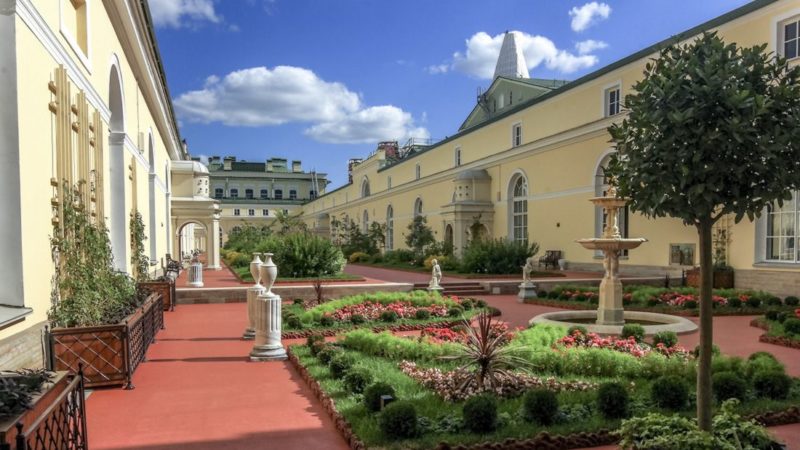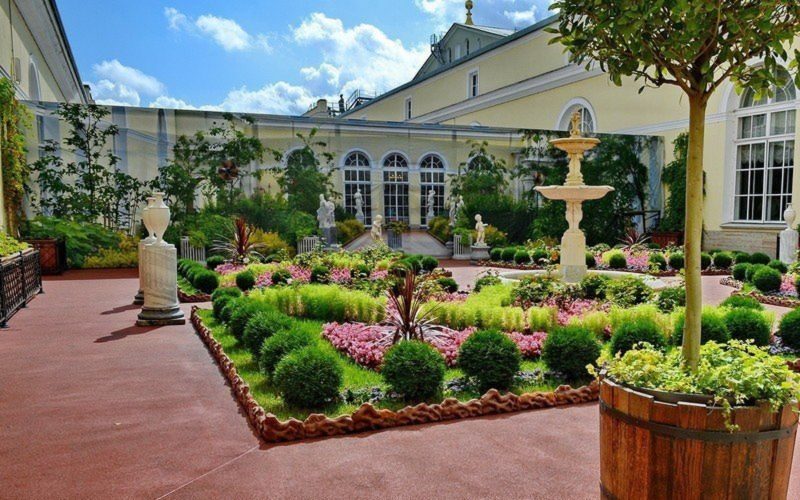The Hanging Garden of the Small Hermitage in St Petersburg

The Hanging Garden of the Small Hermitage is part of the building of the Small Hermitage, which is part of the museum complex of the State Hermitage Museum. The garden was built in 1764–1773 by the architects J. B. Wallen-Delamot and J. M. Felten, and rebuilt in 1841 by V. P. Stasov.
The garden is located on the second floor level, above the premises of the former stables and riding hall, and occupies the space between the galleries connecting the North and South Pavilions of the Small Hermitage.
Closed on all sides by the high walls of the garden has its own microclimate: the proximity of the Neva softens the temperature drops, and the orientation of the garden (from north to south) provides maximum solar illumination throughout the daylight hours. Under the garden there were engineering communications that provided additional heating.
These conditions contribute to the fact that spring in this corner of St. Petersburg comes much earlier, and autumn comes much later. Thanks to the talent of park architects, the flowering of exotic plants and trees in the Hanging Garden of the Small Hermitage begins with the off the snow and ends in late autumn.

The project of creating a garden was very important for Empress Catherine II. She devoted her time to reviewing them during the celebrations held in Moscow on the occasion of her coronation, and on May 5, 1763, the “unfinished garden project” was approved and sent from Moscow to St. Petersburg for revision.
Construction began in 1764 under the direction of architect Yu. M. Felten. In the process of building the southern half of the garden, Felten received an order to attached in the kindergarten the chambers for Count Orlov, now the South Pavilion. Earlier, on the south side, a certain Stone trel'yazh of Betsky was added, which lasted only a few months. Already in 1766, plants began to be planted on the built part of the garden. Here exhibited tubs with flowering "wild orangey and mertasari", delivered from Hamburg. The garden was enclosed with a trelyazhnoy lattice in the form of branches with maple leaves and fruits (work picturesque team Peresinotti).
With the construction of the "Greenhouse" - the North Pavilion on the project J.-B. Wallen Delamot in the period from 1767 to 1769 completed the construction of a garden. The final planning decision of the garden belongs also to the French architect. A greenhouse with the Winter Garden (architect Yu. M. Velten, gardener I. L. Hofmeister) housed in the North Pavilion. In 1768, a decree followed the extension of the two-galleries, western and eastern, connecting the South and North Pavilions. Thus, the Hanging garden was fenced on four sides, the high walls of the side galleries finally hid the garden from the winds, accumulating solar heat.

After reconstruction in 1841, the Hanging Garden was closed for the next reconstruction only in 2004. The restoration work was carried out for several years according to the sketches and notes of Vasily Stasov. Waterproofing, drainage, communications were completely replaced, destroyed plates were replaced with special asphalt. For the period of reconstruction, garden plants were transplanted into a special storage facility. Five sculptures were made by direct copying using modern polymer concrete material.
After the opening in spring 2012, the Hanging Garden of the Small Hermitage appeared before the guests in the form in which Vasily Stasov created it in 1841.
Plants for the Hanging Garden was chosen according to the preserved inventory of 1845. Due to the good location of the site and a certain microclimate, almost any species can be cultivated here. Now in the garden there are saplings of apple trees, plums, currant bushes, raspberries that bloom in spring, produce fruits in summer, and decorate the garden with bright foliage in autumn. Since Soviet times left several bushes Terry lilacs and tulips "Hermitage", donated to the Museum by Holland. Next appeared four flower beds with marigolds, fragrant tobacco, Salvia, small decorative arborvitae on the perimeter and cordyline in the center. All flowers were brought from the Moscow nursery. Along the walls of the lagging parthenocissus and are tubs with Laurus.